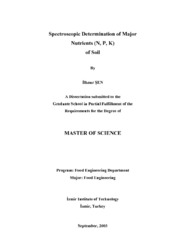Please use this identifier to cite or link to this item:
https://hdl.handle.net/11147/3122Full metadata record
| DC Field | Value | Language |
|---|---|---|
| dc.contributor.advisor | Ertürk, Handan | en |
| dc.contributor.author | Şen, İlknur | - |
| dc.date.accessioned | 2014-07-22T13:50:54Z | - |
| dc.date.available | 2014-07-22T13:50:54Z | - |
| dc.date.issued | 2003 | en |
| dc.identifier.uri | http://hdl.handle.net/11147/3122 | - |
| dc.description | Thesis (Master)--Izmir Institute of Technology, Food Engineering, Izmir, 2004 | en |
| dc.description | Includes bibliographical references (leaves: 84-88) | en |
| dc.description | Text in English; Abstract: Turkish and English | en |
| dc.description | xvi, 99 leaves | en |
| dc.description.abstract | The aim of this study was to determine the major soil nutrients (nitrogen, phosphorus and potassium) which mainly affect the raw material quality of food, using near infrared reflectance spectroscopy (1000-2500 nm). Genetic inverse least squares and partial least squares were used to predict the concentrations of major soil nutrients.The soil samples, collected from Menemen Application and Research Farms, were prepared for the near infrared analysis by using two different methods. According to the first method, two experiments were performed. The soil samples of which were oven dried and screened through a 2 mm sieve, were mixed with NPK fertilizer in the concentration range of 1-15% (wt/wt) (first experiment), and with NH4NO3 and TSP fertilizers in the concentration range of 0.075-0.3% (wt/wt) (second experiment). Using genetic inverse least squares method, regression coefficients of 0.9820, 0.9779 and 0.9906 were obtained for the prediction of nitrogen, phosphorus and potassium concentrations in samples containing NPK fertilizer, respectively. In the second experiment, prediction of nitrogen concentration in samples containing NH4NO3 fertilizer was done reliable with a regression coefficient of 0.8409 using genetic inverse least squares method. On the other hand, regression coefficient of 0.6005 was obtained for the prediction of phosphorus concentration in samples containing TSP fertilizer with the same statistical method.The second method differed from the first one by eliminating the drying of soil samples and moisturizing step following the addition of fertilizers into soil samples. The aim was to prevent baseline shifts in the spectra arising from the moisture changes in the samples. Five types of fertilizer [KNO3, CaNO3, TSP, (NH4)2SO4, NPK] were used in the preparation of samples in the concentration range of 0.02-0.5% (wt/wt). Using genetic inverse least squares method, calibration models produced between the reflectance spectra and the nutrient concentrations had regression coefficients greater than 0.80, however the prediction ability of the models was poor (R2<0.50) except for the samples containing (NH4)2SO4 and NPK fertilizers. The regression coefficients for the prediction of nitrogen and sulfur concentrations in (NH4)2SO4 containing samples were found as 0.8620 and 0.8555, respectively. For the prediction of nitrogen, phosphorus and potassium concentrations in NPK containing samples, the regression coefficients were found as 0.6737, 0.7633 and 0.8724, respectively. The partial least squares method was also used for the prediction of nutrient concentrations in the samples prepared according to the second method. Except samples containing (NH4)2SO4 fertilizer, nitrogen, phosphorus and potassium amounts could not be predicted in the other samples using partial least squares method (R2<0.20). The regression coefficients obtained for the prediction of nitrogen and sulfur amounts in (NH4)2SO4 containing samples were 0.9301.An additional work was carried out with laboratory analyzed soil samples collected from several points of two agricultural fields in Menemen Application and Research Farms. Total nitrogen, extractable phosphorus and exchangeable potassium amounts were determined by Agricultural Engineering Department of Ege University according to the Kjeldahl method, Bingham method and ammonium acetate method, respectively.Predictions of these nutrient concentrations by genetic inverse least squares method were poor (R2< 0.20). Using partial least squares method, the nutrient concentrations could not be predicted (factor number . 0).The results of this study indicate that, near infrared reflectance technique provided rapid, non-destructive and simultaneous determination of nitrogen, phosphorus and potassium concentrations in soil- fertilizer mixtures depending on the sample preparation steps, fertilizer types and concentrations and multivariate calibration methods (genetic inverse least squares and partial least squares methods). | en |
| dc.language.iso | en | en_US |
| dc.publisher | Izmir Institute of Technology | en |
| dc.rights | info:eu-repo/semantics/openAccess | en_US |
| dc.subject.lcc | S596.5 S46 2003 | en |
| dc.subject.lcsh | Soils and nutrition | en |
| dc.subject.lcsh | Soil fertility | en |
| dc.subject.lcsh | Crops and soils | en |
| dc.subject.lcsh | Near infrared spectroscopy | en |
| dc.subject.lcsh | Soils--Nitrogen content | en |
| dc.subject.lcsh | Soils--Phosphorus content | en |
| dc.subject.lcsh | Soils Photassium content. | en |
| dc.title | Spectroscopic determination of major nutrients (N, P, K) of soil | en_US |
| dc.type | Master Thesis | en_US |
| dc.institutionauthor | Şen, İlknur | - |
| dc.department | Thesis (Master)--İzmir Institute of Technology, Food Engineering | en_US |
| dc.relation.publicationcategory | Tez | en_US |
| item.openairecristype | http://purl.org/coar/resource_type/c_18cf | - |
| item.cerifentitytype | Publications | - |
| item.fulltext | With Fulltext | - |
| item.languageiso639-1 | en | - |
| item.grantfulltext | open | - |
| item.openairetype | Master Thesis | - |
| crisitem.author.dept | 03.08. Department of Food Engineering | - |
| Appears in Collections: | Master Degree / Yüksek Lisans Tezleri | |
Files in This Item:
| File | Description | Size | Format | |
|---|---|---|---|---|
| T000242.pdf | MasterThesis | 3.56 MB | Adobe PDF |  View/Open |
CORE Recommender
Page view(s)
118
checked on Apr 15, 2024
Download(s)
64
checked on Apr 15, 2024
Google ScholarTM
Check
Items in GCRIS Repository are protected by copyright, with all rights reserved, unless otherwise indicated.